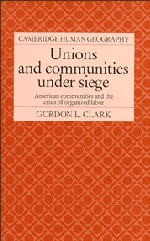Book contents
- Frontmatter
- Contents
- List of tables
- Preface
- Acknowledgments
- PART I ECONOMY AND COMMUNITY
- PART II DRAMA OF ECONOMIC RESTRUCTURING
- PART III UNION PERFORMANCE IN REPRESENTATION ELECTIONS
- PART IV REGULATING LOCAL LABOR–MANAGEMENT RELATIONS
- PART V PROSPECTS FOR ORGANIZED LABOR
- 10 Republicans, Democrats, and the southern veto
- 11 Employment contracts without unions
- 12 Unions and communities unarmed
- Appendix 1 Variables and data sources
- Appendix 2 Cases cited
- Notes
- Bibliography
- Name index
- Subject index
11 - Employment contracts without unions
Published online by Cambridge University Press: 13 October 2009
- Frontmatter
- Contents
- List of tables
- Preface
- Acknowledgments
- PART I ECONOMY AND COMMUNITY
- PART II DRAMA OF ECONOMIC RESTRUCTURING
- PART III UNION PERFORMANCE IN REPRESENTATION ELECTIONS
- PART IV REGULATING LOCAL LABOR–MANAGEMENT RELATIONS
- PART V PROSPECTS FOR ORGANIZED LABOR
- 10 Republicans, Democrats, and the southern veto
- 11 Employment contracts without unions
- 12 Unions and communities unarmed
- Appendix 1 Variables and data sources
- Appendix 2 Cases cited
- Notes
- Bibliography
- Name index
- Subject index
Summary
There is a certain irony in the decline of organized labor and the problematic status of federal labor policy. Although union contracts protect fewer workers from employers' arbitrary decisions, and the National Labor Relations Board appears less reliable in protecting workers' rights as defined by collective bargaining agreements, employers' discretion regarding the treatment of their employees actually seems to have narrowed over the past decade. At the local level, experiments with new forms of labor–management collaboration in nonunion settings have sometimes involved considerable commitment of employers to the welfare of their workers; quasi-union conditions are typical in these settings. In union situations, there have been attempts to broaden workers' discretion in the production process in the hope of increasing labor productivity (witness the partnerships between the United Auto Workers Union and General Motors Corporation in the Saturn Project and the NUMMI plant).
At a broader level, there have been important state-level public policy innovations in nonunion labor–management relations, especially involving limits upon employers' rights of dismissal. Many states have modified the applicability of employment-at-will, the common law doctrine controlling employment relations in nonunion, noncollective bargaining situations. As proscribed in the leading case Payne v. The Western & Atlantic Railroad (1884), employment-at-will provides employers with the right to hire and fire for any reason or no reason, at whatever time they desire. Originally, employment-at-will was simply a practice, legitimated by case law as opposed to statute.
- Type
- Chapter
- Information
- Unions and Communities under SiegeAmerican Communities and the Crisis of Organized Labor, pp. 216 - 238Publisher: Cambridge University PressPrint publication year: 1989



